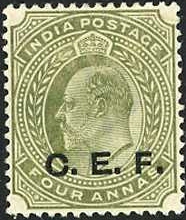|
The 'China Expeditionary Force' (C.E.F) was created at the behest
of the British government in India in 1900. This force consisting of two
brigades was sent to Peking, China during the Boxer uprising. Since regular
exchange of correspondence was foreseen between the soldiers and their
superiors and relatives back in India, a postal staff under Mr. V. T. Van
Sumeran was also sent to China.
The Indian stamps were overprinted with the words C.E.F so that
their use could be monitored within a certain region and thus prevent their
misuse. The postal staff was under orders to issue the stamps only to C.E.F
military personnel in uniform. The postal rates in effect in China were
the same as those prevalent in India at that time. The first use of these
stamps was recorded in August 1900.
As difficulties were experienced in
rendering postal services to the troops stationed at or near railway stations
where there were no post offices, special combined post and railway mail service
between Peking - Taku - Tienstein and Shan Hi Kwan were introduced. The letters
were also sorted, accepted for onward dispatches, in trains, and delivered at
each railway station the trains halted, where the postal staff also sold stamps
and stationary. In August 1901 when a large reduction of troops in China were
made, the postal staff was also reduced with 14 post offices closing down. This
was the largest postal contingent ever set out of India with an expeditionary
force.
Twenty post offices were opened during this
campaign and post offices were provided with distinguishing number as
follows:
| F.P.O. 1 Peking (Legation
Gate) |
F.P.O. 11 Sinho |
| F.P.O. 2 Peking (temple of
Heaven) |
F.P.O. 12 Howhiwa, later
Matoo |
| F.P.O. 3 Tungchoo |
F.P.O. 13 Liu Kung Tao |
| F.P.O. 4 Tienstein (Advance
Base) |
F.P.O. 14 Shan Hi Kwan |
| F.P.O. 5 Shanghai (Tienstein
L. C. Rd) |
F.P.O. 15 Shan Hi Kwan |
| F.P.O. 6 Shanghai |
F.P.O. 16 Chin Wang Tao |
| F.P.O. 7 Peking (Tartar City) |
F.P.O. 17 Wei Hai Wei |
| F.P.O. 8 Unknown |
F.P.O. 18 Tienstein |
| F.P.O. 9 Yangstum |
F.P.O. 19 Reserve |
| F.P.O. 10 Shanghai |
F.P.O. 20 Tienstein or Peking |
In addition to the above post offices, there was
an Indian Base forwarding office in Hongkong. As the main body of Indian troops
were withdrawn in 1906, only six of the main post offices were kept open for the
convenience of the Indian troops, constituting the North China command viz. F.P.O.
- 1, 4, 5, 6, 14 & 15 F.P.O. no. 5 at Tienstein was the only post
office which operated till September 1939, when the last garrison was withdrawn
from North China, by an agreement signed between Great Britain and Japan.
Examples of Indian stamps used from these post
offices are scarce. During this expedition the Peking - Shan Hi Kwan railway was
first divided up between Germany, Japan and Russia but, in February 1901 the
entire railway line was handed over to British authorities for its
administration. A postal box was attached to the railway postal van for the
convenience of the public and a special Chinese stamp , 1/2 cent value was
overprinted BRA/5/cents in three lines for payment of late fee on letters posted
at the last minute. This stamp is found generally used on covers in combination
with C.E.F. stamps.
In the beginning of the expedition the field
post offices were supplied with ordinary Indian stamps but due to the difficulty
in accounting, the Queen Victoria series from 3 pies to Re.1/- were overprinted with the
letters C.E.F. at the Government of India Central Printing office, Calcutta.
These stamps are shown below. They were issued on Aug 16th 1900.
|

Sc
# M1, SG # C1 |

Sc
# M2, SG # C2 |

Sc
# M3, SG # C3 |

Sc
# M4, SG # C4 |

Sc
# M5, SG # C5 |
|

Sc# M6, SG# C6 |

Sc# M7, SG# C7 |

Sc# M8, SG# C8 |

Sc# M9, SG# C9 |

Sc
# M10, SG # C10 |
|

Sc#, SG# C10c (prepared but not issued) |

Sc# M11, SG# C11 (Issued Feb27, 1904) |
Later the Edward series were similarly
overprinted and (C12-20 issued on 16th Sept 1904, C21-22 issued 1908-09) followed by K.G.V watermarked single star series
(issued from 1914-1922). The last series is rarely found used on covers

Sc#
M12, SG# C12 |

Sc# M13, SG#
C13 |

Sc# M14, SG#
C14 |

Sc# M15, SG#
C15 |
|

Sc# M16, SG# C16 |

Sc# M17, SG# C17 |

Sc# M18, SG# C18 |

Sc#
M19, SG# C19 |

Sc# M20, SG#
C20 |

Sc# M21, SG#
C21 |

Sc# M22, SG#
C22 |

Sc#
M23, SG# C23 |

Sc# M24, SG#
C24 |

Sc# M25, SG#
C25 |

Sc# M26, SG#
C26 |
|

Sc# M27, SG# C27 |

Sc# M28, SG# C28 |

Sc# M29, SG# C29 |
|

Sc# M30, SG# C30 |

Sc# M31, SG# C32 |

Sc# M32, SG# C33 |
|

Sc#M33, SG# C34 |
|



































